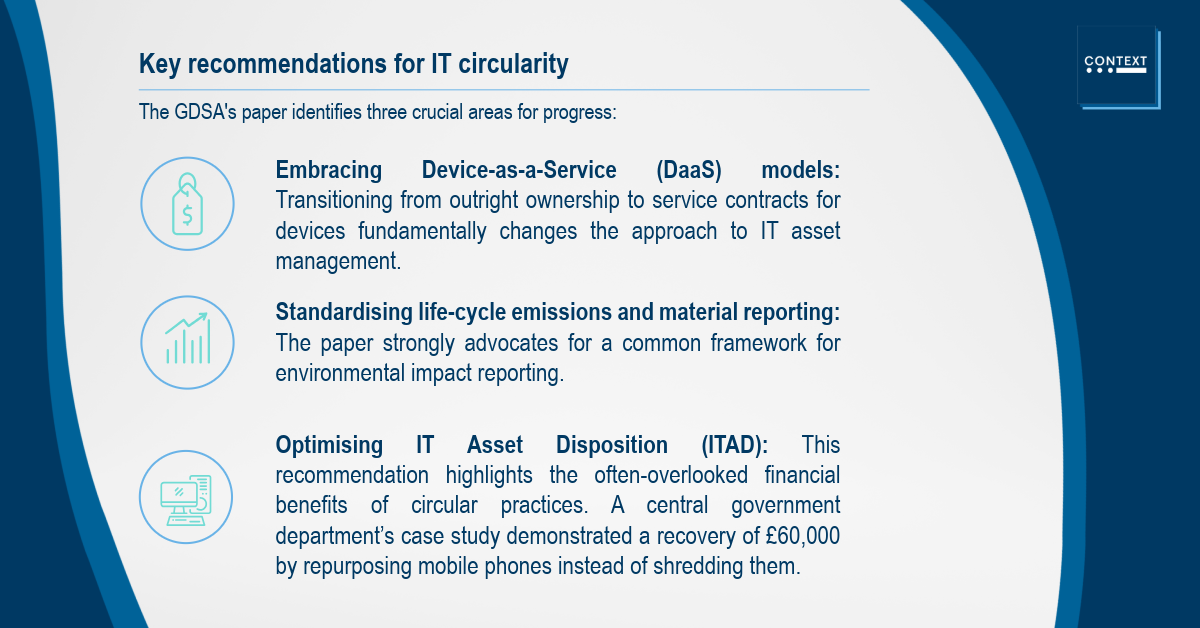The UK Government is leading a
significant shift in digital technology management, moving beyond
traditional procurement to focus on the entire sustainable lifecycle
of IT assets. The Government Digital Sustainability Alliance (GDSA)
Circular Economy Working Group recently published a key recommendation
paper, "Overcoming barriers to drive the circular economy in
digital technologies," outlining a strategic path for IT circularity.
Key recommendations for IT circularity
The GDSA's paper identifies three
crucial areas for progress:
- Embracing Device-as-a-Service (DaaS) models:
Transitioning from outright ownership to service contracts for
devices fundamentally changes the approach to IT asset
management. This model integrates end-of-life take-back,
incentivising providers to design products for reuse and to
manage decommissioned assets responsibly. Beyond environmental
benefits, DaaS models can streamline capital expenditure and
align vendor revenue with ongoing product stewardship.
- Standardising life-cycle emissions and material
reporting: The paper strongly advocates for a common
framework for environmental impact reporting. By adopting
methodologies such as the EU Product Environmental Footprint for
Scope 3 reporting, organisations can accurately track the carbon
and resource impacts of their IT products. This standardisation
facilitates effective benchmarking, the setting of science-based
targets, and transparent progress reporting to
stakeholders.
- Optimising IT Asset Disposition
(ITAD): This recommendation highlights the often-overlooked
financial benefits of circular practices. A central government
department’s case study demonstrated a recovery of £60,000 by
repurposing mobile phones instead of shredding them. This
illustrates that adjustments in disposition policy can unlock
significant hidden value, confirming that circular economy
measures offer both financial and environmental advantages.

Implications for the IT industry
The GDSA's recommendations extend
beyond government departments, providing vital guidance for the entire
IT industry:
- Transforming procurement: Traditional
procurement approaches are evolving. Environmental, Social, and
Governance (ESG) and circularity criteria are rapidly becoming
mandatory elements in Request for Proposals (RFPs) and tenders.
To comply with regulations and meet buyer demand, businesses
must integrate durability, reparability, and upgradability into
their core sourcing policies.
- Enhancing ESG data
accessibility and visibility: Transparency is crucial.
Companies should publish clear, point-of-purchase metrics,
including information on repairability, upgrade paths, expected
lifespan, and methods to extend product life, alongside
total-cost-of-ownership and carbon footprints. This level of
transparency fosters trust and expedites buyer decision-making.
- Standardising life-cycle emissions and material
reporting: Adopting a common methodology, such as the EU
Product Environmental Footprint, for Scope 3 emissions and
material use is critical. Consistent reporting enables
benchmarking, effective target-setting, and credible disclosure
to stakeholders, fostering a more sustainable and accountable
industry.
The circular future of IT
While 2025 marks a pivotal point in
the journey toward IT sustainability, the full realisation of a
circular economy for digital technologies will likely unfold over the
coming years. The UK government's leadership through the GDSA
highlights a growing global imperative, not just for compliance, but
for unlocking financial value, building trust, and laying the
foundation for a more resilient and sustainable digital future.
To stay up to date
with the latest news, sign up to our newsletter
dedicated to ESG .